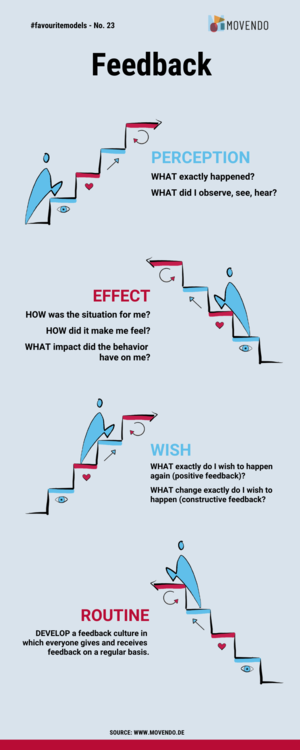#favouritemodel No. 23 - Feedback

That's a shame, because actually giving feedback to employees is both a "superpower" and at the same time a "super duty" for a leader. As a leader, giving feedback on one hand gives me the unique opportunity to express my appreciation and recognition to the employee and, on the other hand, to support him or her to develop. Feedback basically refers to observed behavior that I find good and helpful and therefore want to give positive feedback, as well as to observed behavior that I find obstructive or inappropriate and therefore want to give the other person the opportunity to change it.

The principles for feedback are that:
- I want to give the other person a learning opportunity
- I have a positive intention in doing so, and
- I also assume that the other person is acting to the best of his or her knowledge and belief.
It is most helpful if the entire team develops and aligns on a feedback culture in which everyone gives and receives feedback on a regular basis. And this is best done promptly, as soon as I have observed a behavior that I want to give feedback on (i.e. not waiting for the so-called annual review to then give feedback 1 or 2 times a year).
When I want to provide feedback on an observed behavior, the following process is worthwhile:
Perception
What exactly happened? What did I observe, see, hear?
Here I describe to the other person as precisely as possible what situation I have in my mind's eye so that he or she can understand what the feedback refers to.
Effect
How was the situation for me? How did it make me feel? What impact did the behavior have on me?
If I was upset about something, I address it the same way as if I found something really good or helpful.
Wish
What exactly do I want you to do again (positive feedback) or change (constructive feedback)?
Herewith I verbalize what I wish.
This wish, as well as my perception and the effect it had on me, are subjective and represent nothing more, but also nothing less than my personal perception and opinion. And it is more than likely that this is exactly what employees very much want from their team leaders: namely, an individual discussion of their work results and the alignment of goals and expectations.
Accepting feedback is just as essential as giving it. It is worthwhile to simply listen to the person giving the feedback and to resist the impulse to spontaneously justify or explain oneself. This also applies to both positive and constructive feedback
How does my #favouritemodel help you?
It pays off to establish a feedback culture with your team. When "face-saving" feedback becomes the norm, it's much easier to talk to each other instead of about each other. This is essential for a trusting atmosphere and promotes motivation, while at the same time allowing you to focus on the work at hand.
As a manager, make it a habit to give feedback even on "purely positive" reasons and not to express praise simply by remaining silent. It is also a "superpower" to regularly ask employees for feedback and thus invite them to participate in your own further development.










